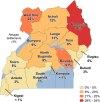Exploring the role of spending on malaria incidence in Uganda using the auto-regressive distributed lag approach
- PMID: 38689274
- PMCID: PMC11062013
- DOI: 10.1186/s12936-024-04929-8
Exploring the role of spending on malaria incidence in Uganda using the auto-regressive distributed lag approach
Abstract
Background: Malaria has remained a persistent global health problem. Despite multiple government and donor initiatives to eradicate malaria and its detrimental effects on Uganda's health outcomes, the incidence of malaria is worrying as it appears higher than the average of 219 cases per 1000 for sub-Saharan Africa for the period 2017-2018. This study investigated the effect of public and private healthcare spending on the incidence of malaria in Uganda.
Methods: Employing time series data spanning over 20 years from the first quarter of 2000 to the last quarter of 2019, the study builds a model based on the Grossman framework for analysing demand for health. The estimation technique used was the ARDL approach that takes into account reverse causality and incidental relationships. Prior to the adoption of the technique, a bounds test was performed to determine whether the variables contained in the model have a long-term relationship. Several diagnostic tests for serial correlation, functional normality, and heteroskedastic specification error were carried out to verify the ARDL model's goodness of fit. Additionally, the cumulative sum of recursive (CUSUM) and cumulative sum of squares of recursive residuals (CUSUMSQ) were used to test model stability.
Results: The results indicate that in the long run, an increase in public spending of one percent significantly reduces malaria incidence by 0.196 at the 10 percent level of significance. On the other hand, there is no significant evidence of private health expenditure's effect on malaria incidence. However, in the short run, public spending reduces malaria incidence by a smaller magnitude of 0.158 percent relative to the long-run. Still, private expenditure is found to exhibit no significant effect. Additional findings point to the importance of GDP per capita and urban population growth in reducing malaria incidence, whereas female unemployment, income inequality, as well as female-headed household. In the short run, however, the female-headed households and urban population growth are found to significantly reduce malaria incidence while an improvement in regulatory quality decreases malaria incidence by 0.129 percent.
Conclusions: There is need for further government interventions to reduce malaria incidence in the country via budget allocation, as well as the strengthening of programmes to raise household income to support private health spending, in addition to the development of strategies to promote well-planned and organized urban centres.
Keywords: ARDL; Health expenditure; Malaria Incidence; Uganda.
© 2024. The Author(s).
Conflict of interest statement
The authors of this manuscript declare no conflict of interest.
Figures
Similar articles
-
Examining geographical inequalities for malaria outcomes and spending on malaria in 40 malaria-endemic countries, 2010-2020.Malar J. 2024 Jul 10;23(1):206. doi: 10.1186/s12936-024-05028-4. Malar J. 2024. PMID: 38982498 Free PMC article.
-
Past, present, and future of global health financing: a review of development assistance, government, out-of-pocket, and other private spending on health for 195 countries, 1995-2050.Lancet. 2019 Jun 1;393(10187):2233-2260. doi: 10.1016/S0140-6736(19)30841-4. Epub 2019 Apr 25. Lancet. 2019. PMID: 31030984 Free PMC article.
-
Examining malaria treatment and prevention spending efficiency in malaria-endemic countries, 2000-2020.Malar J. 2024 Nov 9;23(1):333. doi: 10.1186/s12936-024-05165-w. Malar J. 2024. PMID: 39521995 Free PMC article.
-
Hong Kong's domestic health spending--financial years 1989/90 through 2004/05.Hong Kong Med J. 2008 Apr;14 Suppl 2:2-23. Hong Kong Med J. 2008. PMID: 18587162 Review.
-
Narrative review of current context of malaria and management strategies in Uganda (Part I).Acta Trop. 2015 Dec;152:252-268. doi: 10.1016/j.actatropica.2015.07.028. Epub 2015 Aug 7. Acta Trop. 2015. PMID: 26257070 Review.
Cited by
-
From need to neglect: Exploring psychological barriers to preventive interventions in pregnancy.PLOS Glob Public Health. 2025 Jun 24;5(6):e0004826. doi: 10.1371/journal.pgph.0004826. eCollection 2025. PLOS Glob Public Health. 2025. PMID: 40554525 Free PMC article.
-
Comprehensive analysis of molecular markers linked to antimalarial drug resistance in Plasmodium falciparum in Northern, Northeastern and Eastern Uganda.Malar J. 2025 Jun 13;24(1):190. doi: 10.1186/s12936-025-05439-x. Malar J. 2025. PMID: 40514714 Free PMC article.
References
-
- WHO. World Malaria Report 2019. Geneva: World Health Organization; 2019.
-
- WHO. World Malaria Report 2020. Geneva: World Health Organization; 2020.
-
- WHO. World Malaria Report 2022. Geneva: World Health Organization; 2022.
-
- Ministry of Health. National Malaria Control Programme. Uganda, Kampala, 2018.
MeSH terms
LinkOut - more resources
Full Text Sources
Medical


